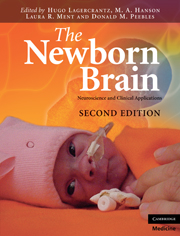Book contents
- Frontmatter
- Contents
- List of contributors
- Preface to the First Edition
- Preface to the Second Edition
- 1 Reflections on the origins of the human brain
- Section 1 Making of the brain
- Section 2 Sensory systems and behavior
- Section 3 Radiological and neurophysiological investigations
- Section 4 Clinical aspects
- 16 Infection, inflammation, and damage to fetal and perinatal brain
- 17 Hypoxic–ischemic encephalopathy
- 18 Clinical assessment and therapeutic interventions for hypoxic–ischemic encephalopathy in the full-term infant
- 19 Clinical aspects of brain injury in the preterm infant
- Section 5 Follow-up
- Section 6 Consciousness
- Index
- Plate section
- References
17 - Hypoxic–ischemic encephalopathy
from Section 4 - Clinical aspects
Published online by Cambridge University Press: 01 March 2011
- Frontmatter
- Contents
- List of contributors
- Preface to the First Edition
- Preface to the Second Edition
- 1 Reflections on the origins of the human brain
- Section 1 Making of the brain
- Section 2 Sensory systems and behavior
- Section 3 Radiological and neurophysiological investigations
- Section 4 Clinical aspects
- 16 Infection, inflammation, and damage to fetal and perinatal brain
- 17 Hypoxic–ischemic encephalopathy
- 18 Clinical assessment and therapeutic interventions for hypoxic–ischemic encephalopathy in the full-term infant
- 19 Clinical aspects of brain injury in the preterm infant
- Section 5 Follow-up
- Section 6 Consciousness
- Index
- Plate section
- References
Summary
The role of hypoxia–ischemia in perinatal brain injury
Injury to the brain depends on not only the type and severity of insult, but also the maturity of the tissue. Hypoxic–ischemic encephalopathy is generally considered to be characteristic of the term infant who has experienced a severe perinatal deficit in cerebral oxygen delivery leading to disruption of cerebral energy metabolism (Volpe, 1994). This is frequently followed by a global hypoxic–ischemic injury, with a widespread although not uniform distribution of apoptotic and necrotic cell death. Nevertheless, focal cerebral infarction is also seen in term infants, and may be underdiagnosed unless sophisticated techniques such as diffusion-weighted magnetic resonance imaging (MRI) are used (Cowan et al., 1994). Hypoxic–ischemic changes are also seen in many stillbirths although in these infants apoptotic death may be particularly prominent (Edwards et al., 1997).
Uncertainty about the role of intrauterine hypoxemia or cerebral ischemia is exacerbated by the imprecise measures of fetal oxygenation or cerebral blood flow available to clinicians. Observations of clinical variables such as cardiotocography or meconium staining of the liquor may mislead if interpreted as precise measures of fetal cerebral hypoxia and ischemia (Nelson et al., 1998). However, more accurate techniques such as magnetic resonance spectroscopy (MRS) have defined at least a subgroup of infants with characteristic hypoxic–ischemic injury, and it is clear that cerebral hypoxia and/or ischemia is involved in a significant proportion of neonatal encephalopathy (Azzopardi et al., 1989).
- Type
- Chapter
- Information
- The Newborn BrainNeuroscience and Clinical Applications, pp. 261 - 280Publisher: Cambridge University PressPrint publication year: 2010



